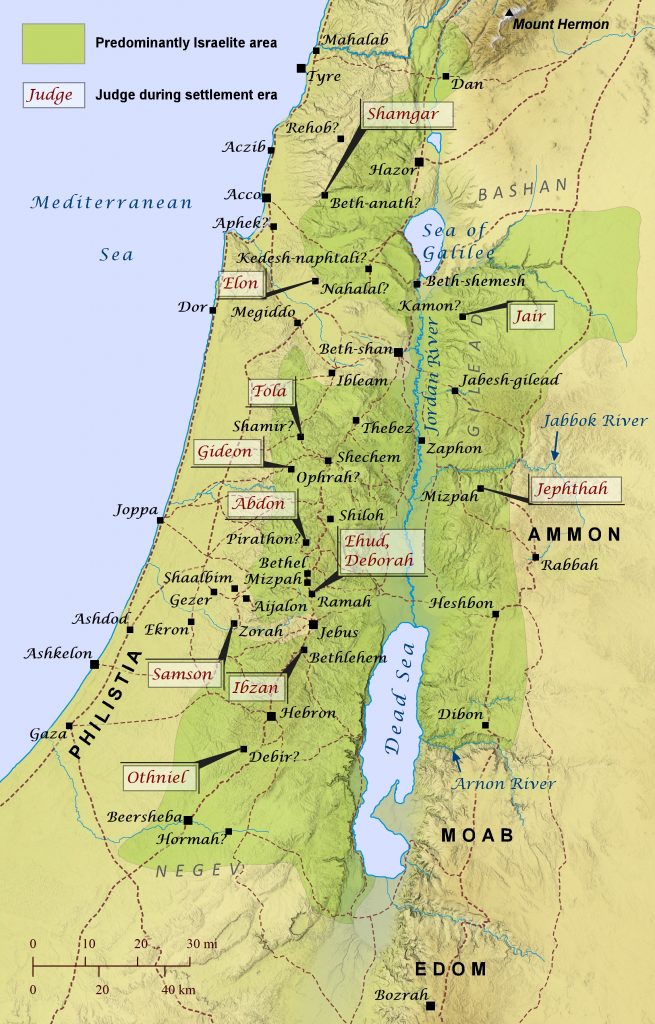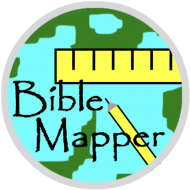Judges 2-16
Under Joshua’s leadership the Israelites conquered and occupied most of Canaan, but Canaanites continued to occupy many parts of the land, particularly the valleys and the coastal areas. From time to time these Canaanites oppressed the Israelites, and the Lord raised up local leaders to help the Israelites fight against them. Often these local leaders then continued to serve as civic judges over the people throughout their lifetime. The book of Judges details the exploits of twelve of these leaders: Othniel, Shamgar, Deborah, Gideon, Tola, Jair, Jephthah, Ibzan, Elon, Abdon, Samson, and Ehud.

⤓ download hi-res file 🔍 see in TimeGlider
Jesus’ Birth and Escape to Egypt
The story of Jesus’ birth begins in the village of Nazareth, where Joseph and Mary lived (Luke 2:1-7). The angel Gabriel appeared to Mary there and announced to her that she would give birth to the Messiah. As the time drew near for Jesus to be born, Mary and Joseph traveled to Bethlehem, the town of their ancestor David, to be counted in a Roman census. There Mary gave birth to Jesus. Perhaps as much as two years later astrologers called Magi came from the East to worship the newborn king of the Jews, because a star in the heavens signaled that he had been born, and it directed them to Jerusalem (Matthew 2:1-2). The Magi asked King Herod where the child was, and he asked the leading priests and teachers of the law, who pointed them to Bethlehem. So the Magi traveled five miles south to Bethlehem, and the star directed them to the house where Jesus and his family lived. There the Magi worshiped Jesus and gave him gifts of gold, frankincense, and myrrh (Matthew 2:3-12). An angel then warned Joseph in a dream to flee to Egypt with his family to escape Herod’s plan to kill the newborn king (Matthew 2:13-18). After Herod died, an angel told Joseph to return to Israel with Mary and Jesus, and they settled in their quiet hometown of Nazareth to avoid being discovered by Herod’s son Archelaus (Matthew 2:19-23).

⤓ download hi-res file 🔍 see in TimeGlider
Jerusalem during the New Testament
By the time of the New Testament, the ancient city of Jerusalem had been transformed from the relatively small fortress of David’s day (2 Samuel 5:6-10; 1 Chronicles 11:4-9) into a major city with a Temple that rivaled the greatest temples in the Roman world. Just prior to Jesus’ birth, Herod the Great completely renovated and expanded the Temple of the Lord, and he also built a lavish palace for himself, various pools (where Jesus occasionally performed healings), public buildings, and military citadels, including the Antonia Fortress, which overlooked the Temple. Wealthy residents, including the high priest, occupied extravagant houses in the Upper City, while the poorer residents were relegated to less desirable areas like the Lower City. The Essene Quarter was so named because many of its residents belonged to the Essenes, a strict religious sect that was known for its careful attention to the law of Moses. Across the Kidron Valley lay the Garden of Gethsemane, where Jesus often met with his disciples (Matthew 26:36-46; Mark 14:32-53; John 18:1-14). Further east was the Mount of Olives, where Jesus began his triumphal entry one week before his crucifixion (Matthew 21:1-11; Mark 11:1-11; Luke 19:28-40; John 12:12-19), taught his disciples about the last days (Matthew 24-25; Mark 13), and eventually ascended to heaven after his resurrection (Luke 24:50-53; Acts 1:1-11).

⤓ download hi-res file 🔍 see in TimeGlider
Jacob Returns to Canaan
As Jacob returned to Canaan from Haran, he likely crossed the Jabbok River at the King’s Highway and headed west into the hills of Gilead (Genesis 31). He sent messengers to Seir over seventy miles southwest (see “The Negev” map) to find his brother Esau and seek his favor. The messengers returned with news that Esau was coming with four hundred men to meet Jacob, and Jacob prepared for the worst (Genesis 32:1-21). While Jacob was camped at Mahanaim, he divided all his family, servants, and livestock into two groups and sent them across the Jabbok River, but Jacob stayed back at the camp by himself. All during the night a man wrestled with him until Jacob compelled him to bless him, and the man changed Jacob’s name to Israel. So Jacob named the place Peniel (likely the hill on the other side of the Jabbok River; see “Mahanaim and Peniel” map) and headed out to meet Esau (Genesis 32:22-32). When Esau arrived, he embraced Jacob, and the two brothers were reconciled. Esau then returned to Seir while Jacob journeyed on to Succoth and built a house for his family and booths for his livestock. Sometime after this Jacob left and traveled to Shechem in the heart of Canaan (Genesis 33).

The World of the Patriarchs
Abraham, the father of the Israelites, grew up in the ancient city of Ur of the Chaldeans, but he moved to Haran with his father Terah, his wife Sarai, and his nephew Lot (Genesis 11:27-31). At this time in history the Chaldeans (Kasdim) inhabited the area east of Haran, making it unlikely that Abraham’s city of Ur was the one located in southern Babylonia. After his father died, Abraham completed his family’s original intention to move to Canaan (Genesis 12:1-5), and the Lord promised to give Canaan to him and his descendants. After he reached Canaan, Abraham first set up camp in Shechem, but he continued to move throughout the land from time to time (Genesis 12-20). Later he traveled to Egypt to find relief from a famine, but then he returned to Canaan once again (Genesis 12:10-20). Abraham’s son Isaac grew up in Canaan (Genesis 21-22), but when it came time for him to marry, Abraham sent his servant back to Haran to find a wife for him there (Genesis 24). Later Isaac’s son Jacob also traveled from Canaan to Haran to escape the wrath of his twin brother Esau, and he married two women from there (Genesis 27-29; see “Jacob Goes to Paddan-Aram” map). Jacob returned to Canaan (Genesis 31; see “Jacob Returns to Canaan” map), but when he was old he moved his whole family to Egypt during Joseph’s time there as second in command to Pharaoh (Genesis 46).

